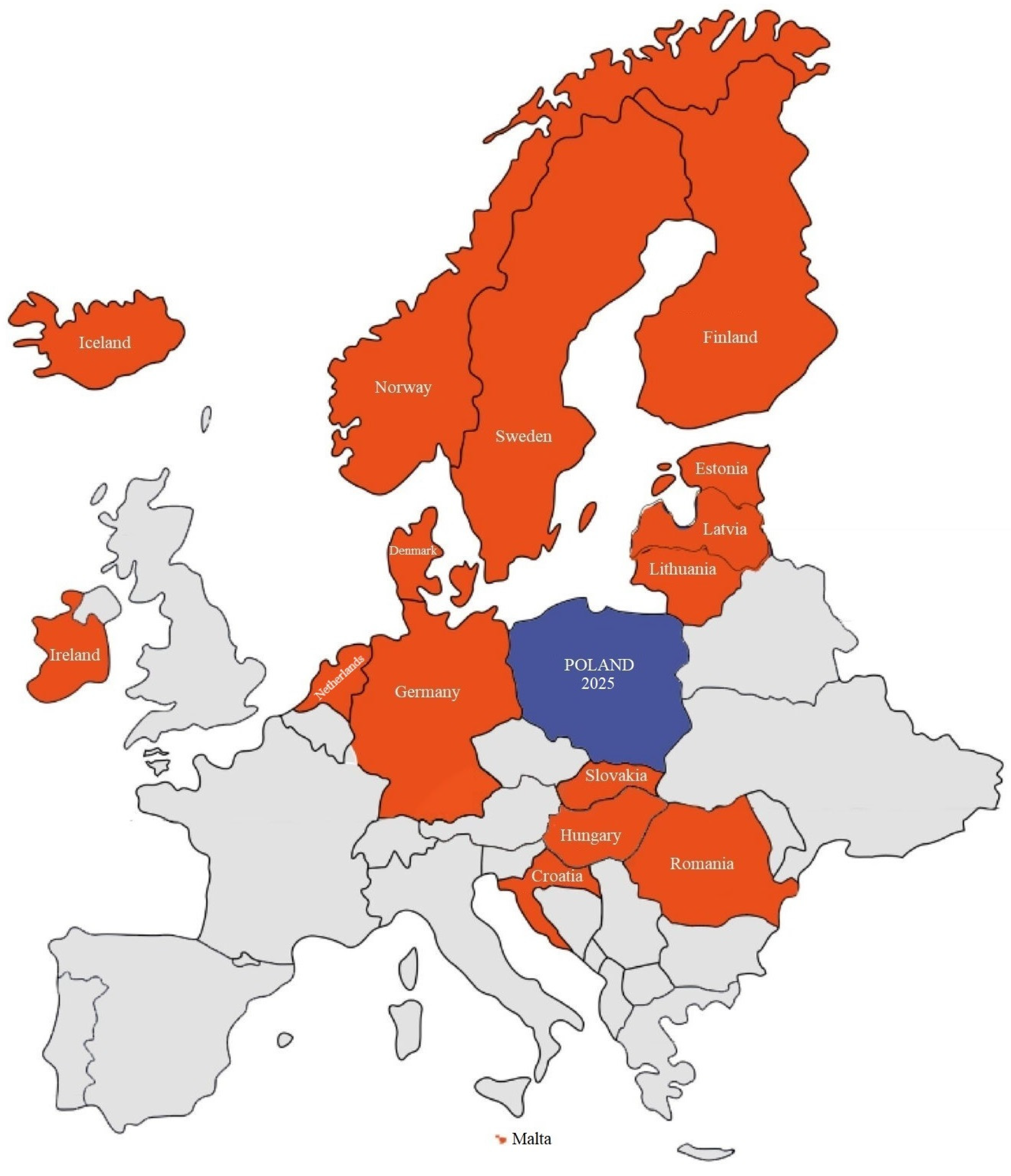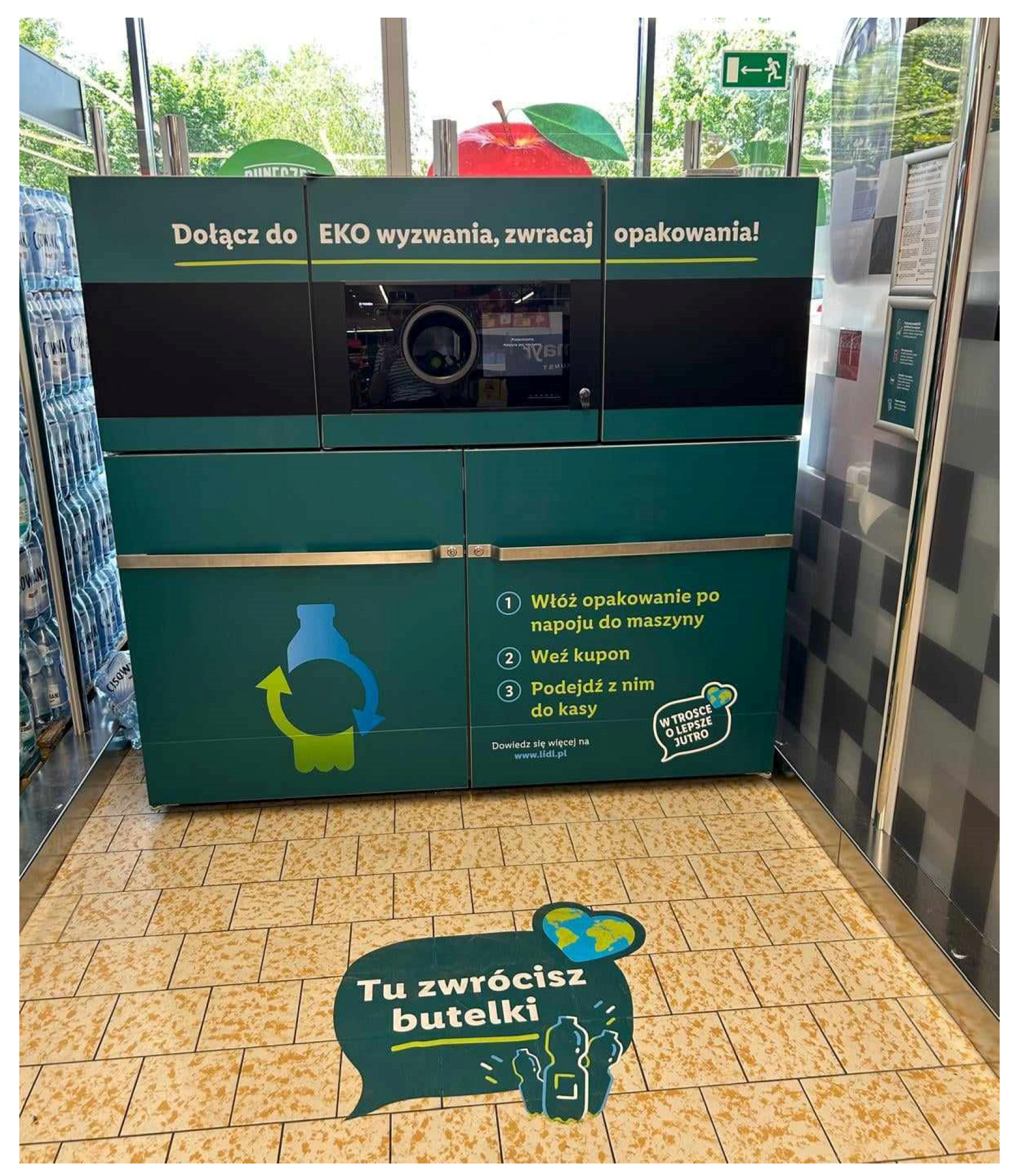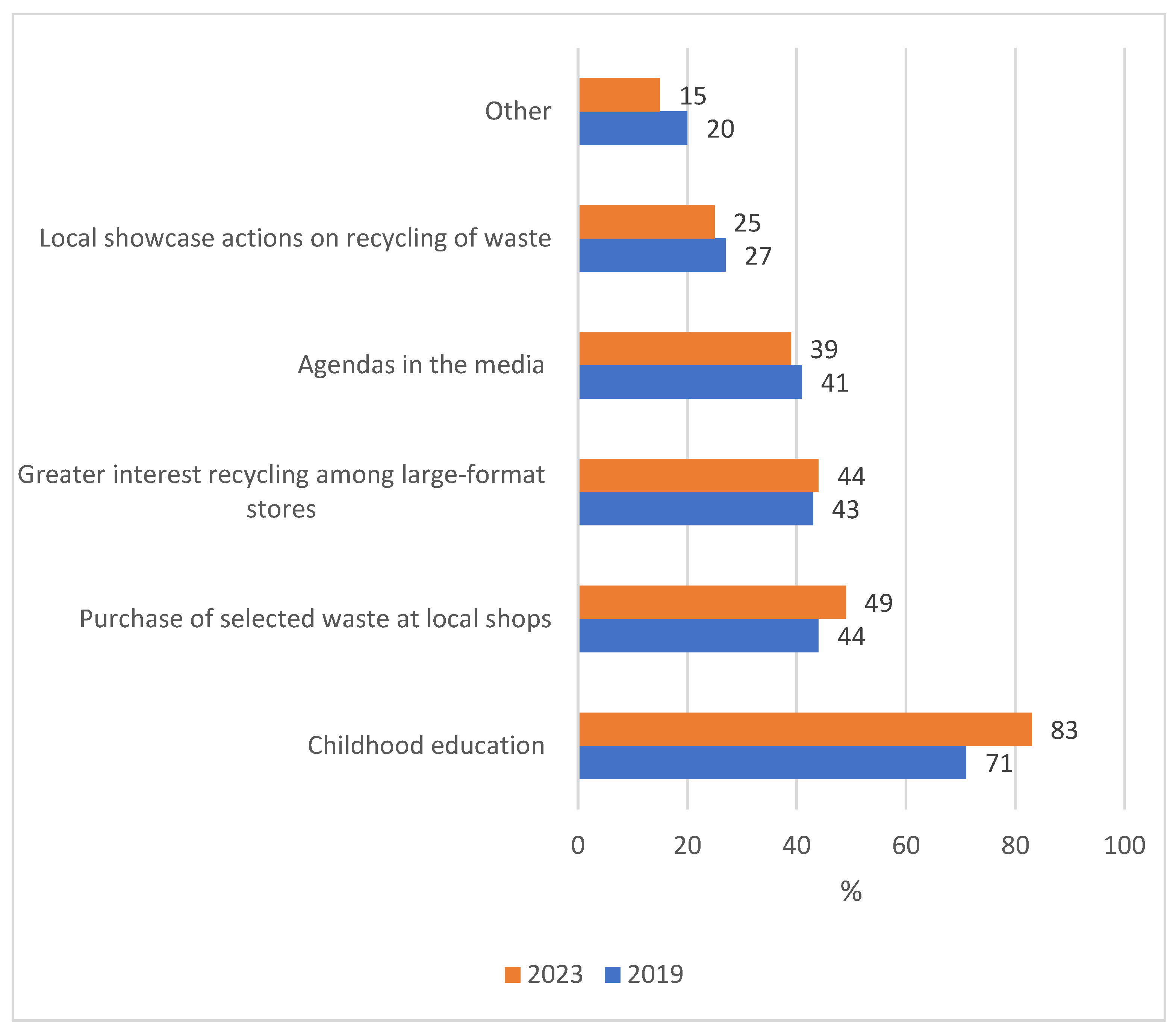Implementation of the Deposit System in Poland as a Tool for Implementing the Circular Economy
Abstract
:1. Introduction
2. Materials and Methods
- Analysis of the subject literature;
- Tabular and descriptive charts;
- Survey method;
- Deductive method;
- Analysis of source documents.
3. Results
3.1. The Deposit System in Poland and Other European Countries
- Biodegradable waste—51 kg per inhabitant (49 kg in 2021);
- Glass—21 kg per inhabitant (21 kg in 2021);
- Bulky waste—17 kg per inhabitant (20 kg in 2021);
- Mixed packaging waste—15 kg per inhabitant (16 kg in 2021);
- Paper and cardboard—15 kg per inhabitant (14 kg in 2021);
- Plastics—14 kg per inhabitant (14 kg in 2021).
- Plastics: mainly PET bottles—polyethylene terephthalate (in Norway also HDPE: high-density polyethylene),
- Metals: mainly aluminum cans; additionally, tin-plated packaging in Croatia, Sweden and Norway; steel packaging in Estonia,
- Glass: depending on the country, including bottles of beer, juices, soft drinks, weak alcohol (less than 10%), and strong alcohol (only collected in Finland).
- VAT deposit exemption (for disposable and reusable packaging);
- Collecting a deposit at every stage of sale;
- Increasing the deposit to PLN 1 for reusable glass bottles;
- Maintaining a low product fee for failure to meet the required collection levels in the first year of operation of the deposit system (in 2025, it is 77%);
- Ability to return reusable glass packaging wherever they are sold;
- Postponing the collection of milk and dairy product packaging under the deposit system to 2026;
- Keeping disposable glass packaging outside the system (including “monkeys”, juices, alcohol);
- Inclusion of standard glass packaging (various types of bottles and jars) in the refund system gradually from 2026;
- Minimum one collection point in each commune.
3.2. Barriers to the Implementation of the Deposit System in Poland
3.3. Benefits of the Implementation of the Deposit System in Poland
4. Discussion
5. Conclusions
Author Contributions
Funding
Institutional Review Board Statement
Informed Consent Statement
Data Availability Statement
Conflicts of Interest
References
- COM 98/2020 Final. Communication from the Commission to the European Parliament, the Council, the European Economic and Social Committee and the Committee of the Regions, A New Circular Economy Action Plan for a Cleaner and More Competitive Europe. Available online: https://eur-lex.europa.eu/legal-content/EN/TXT/?uri=COM%3A2020%3A98%3AFIN (accessed on 1 October 2024).
- COM/2023/306 Final. Communication from the Commission to the European Parliament, the Council, the European Economic and Social Committee and the Committee of the Regions on a Revised Monitoring Framework for the Circular Economy. Available online: https://eur-lex.europa.eu/legal-content/PL/TXT/?uri=CELEX:52023DC0306 (accessed on 1 August 2024).
- Geissdoerfer, M.; Savaget, P.; Bocken, N.; Jan Hultink, E. The Circular Economy—A New Sustainability Paradigm? J. Clean. Prod. 2017, 143, 757–768. [Google Scholar] [CrossRef]
- Smol, M.; Kulczycka, J.; Avdiushchenko, A. Circular economy indicators in relation to eco-innovation in European regions. Clean Technol. Environ. Policy 2017, 19, 669–678. [Google Scholar] [CrossRef]
- Stahel, W. The Circular Economy: A User’s Guide, 1st ed.; Routledge: London, UK; New York, NY, USA, 2019; ISBN 978-0-367-20014-5. [Google Scholar]
- Kopnina, H.; Poldner, K. Circular Economy Challenges and Opportunities for Ethical and Sustainable Business; Routledge: London, UK; New York, NY, USA, 2022. [Google Scholar]
- Zarębska, J. Zagospodarowanie Odpadów Opakowaniowych w Kontekście Gospodarki o Obiegu Zamkniętym—Istota, Narzędzia, Komunikacja Środowiskowa, 1st ed.; Oficyna Wydawnicza Uniwersytetu Zielonogórskiego: Zielona Góra, Poland, 2019; pp. 30–72. (In Polish) [Google Scholar]
- Gregorio, V.F.; Pie, L.; Terceno, A. A Systematic Literature Review of Bio, Green and Circular Economy Trends in Publications in the Field of Economics and Business Management. Sustainability 2018, 10, 4232. [Google Scholar] [CrossRef]
- Lewicka, D.; Zarębska, J.; Batko, R.; Woźniak, M.; Cichoń, D.; Tarczydło, B.; Pec, M. Circular Economy in the European Union Organisational Practice and Future Directions in Germany, Poland and Spain, 1st ed.; Routledge: London, UK; New York, NY, USA, 2023; pp. 42–56. [Google Scholar] [CrossRef]
- Weetman, C. A Circular Economy Handbook: How to Build a More Resilient, Competitive and Sustainable Business, 2nd ed.; Kogan Page Ltd.: London, UK, 2020; pp. 250–348. [Google Scholar]
- Zarębska, J.; Zarębski, A.; Lewandowska, A. Polish society towards the implementation of the circular economy and the change of municipal waste management—Ecological, economic and social aspect. Management 2021, 25, 91–112. [Google Scholar] [CrossRef]
- The 2030 Agenda and the Sustainable Development Goals An opportunity for Latin America and the Caribbean. 2018. Available online: https://repositorio.cepal.org/server/api/core/bitstreams/6321b2b2-71c3-4c88-b411-32dc215dac3b/content (accessed on 28 April 2024).
- Directive (EU) 2018/850 of the European Parliament and of the Council of 30 May 2018 Amending Directive 1999/31/EC on the Landfill of Waste (Text with EEA Relevance). Available online: https://eur-lex.europa.eu/legal-content/EN/TXT/PDF/?uri=CELEX:32018L0850 (accessed on 1 October 2024).
- Directive (EU) 2018/851 of the European Parliament and of the Council of 30 May 2018 amending Directive 2008/98/EC on waste (Text with EEA relevance). Available online: https://eur-lex.europa.eu/eli/dir/2018/851/oj (accessed on 1 October 2024).
- Directive (EU) 2018/852 of the European Parliament and of the Council of 30 May 2018 Amending Directive 94/62/EC on Packaging and Packaging Waste (Text with EEA Relevance). Available online: https://eur-lex.europa.eu/eli/dir/2018/852/oj (accessed on 1 October 2024).
- Directive (EU) 2019/904 of the European Parliament and of the Council of 5 June 2019 on the Reduction of the Impact of Certain Plastic Products on the Environment (Text with EEA Relevance). Available online: https://eur-lex.europa.eu/eli/dir/2019/904/oj (accessed on 1 October 2024).
- Dalhammar, C. Industry attitudes towards ecodesign standards for improved resource efficiency. J. Clean. Prod. 2016, 123, 155–166. [Google Scholar] [CrossRef]
- Lee, C.K.; Lee, J.Y.; Choi, Y.H.; Lee, K.M. Application of the integrated ecodesign method using the GHG emission as a single indicator and its GHG recyclability. J. Clean. Prod. 2016, 112, 1692–1699. [Google Scholar] [CrossRef]
- Eurostat. Available online: https://ec.europa.eu/eurostat (accessed on 5 April 2024).
- EEA Report 13/2023. Accelerating the Circular Economy in Europe. State and Outlook 2024. Available online: https://s3-eu-west-1.amazonaws.com/avfall-norge-no/dokumenter/EEA-report-Accelerating-the-circular-economy-in-Europe-State-and-outlook-2024.pdf (accessed on 28 March 2024).
- GUS. Ochrona Środowiska 2023. Available online: https://stat.gov.pl/obszary-tematyczne/srodowisko-energia/srodowisko/ochrona-srodowiska-2023,1,24.html (accessed on 3 May 2024). (In Polish)
- De Pascale, A.; Di Vita, G.; Giannetto, C.; Ioppolo, G.; Lanfranchi, M.; Limosani, M.; Szopik-Depczyńska, K. The circular economy implementation at the European Union level. Past, present and future. J. Clean. Prod. 2023, 423, 138658. [Google Scholar] [CrossRef]
- Plastics Europe, Plastics—The Fast Facts 2023, Plastics Europe. Available online: https://plasticseurope.org/knowledge-hub/plastics-the-fast-facts-2023/ (accessed on 3 May 2024).
- Topics. European Parliament. Available online: https://www.europarl.europa.eu/topics/en/article/20231109STO09917/how-to-reduce-packaging-waste-in-the-eu-infographics (accessed on 3 May 2024).
- Ellen MacArthur Foundation. Intelligent Assets: Unlocking the Circular Economy Potential. 2016. Available online: https://www.ellenmacarthurfoundation.org/assets/downloads/publications/EllenMacArthurFoundation_Intelligent_Assets_080216.pdf (accessed on 2 February 2024).
- Tugce Tugran. Deposit Refund Systems in the EU. 2023 Update. The Association of Cities and Regions (ACR+). Available online: https://www.acrplus.org/media/origin/images/technical-reports/2023_ACR_Deposit_Refund_Systems_EU_Report.pdf (accessed on 20 March 2024).
- Teraz Środowisko. 2023. Available online: https://www.teraz-srodowisko.pl/aktualnosci/system-kaucyjny-w-polsce-projekt-ustawy-mkis-12490.html (accessed on 2 February 2024). (In Polish).
- Ustawa z Dnia 13 Lipca 2023 r. o Zmianie Ustawy o Gospodarce Opakowaniami i Odpadami Opakowaniowymi Oraz Niektórych Innych Ustaw (Dz. U. 2023, Poz. 1852). Available online: https://isap.sejm.gov.pl/isap.nsf/download.xsp/WDU20230001852/O/D20231852.pdf (accessed on 20 March 2024). (In Polish)
- System kaucyjny od 2025 roku—Kaucja bez VAT. Available online: https://www.inforlex.pl/dok/tresc,FOB0000000000006524666,System-kaucyjny-od-2025-roku-kaucja-bez-VAT.html (accessed on 11 March 2024). (In Polish).
- Bielenstein, T. Refillable Bottle Systems in Germany—A Model for Well-Designed Pool Systems in Europe? Zero Waste Europe Webinar. 10 May 2022. Available online: https://zerowastecities.eu/wp-content/uploads/2022/05/220510_Presentation_Zero_Waste_Europe.pdf (accessed on 30 May 2023).
- Malowaniec, B. Gospodarka Odpadami Opakowaniowymi po Napojach w Polsce: Teraz i w Niedalekiej Przyszłości. Systemy Kaucyjne w Wybranych Krajach Europejskich. Wydawnictwo Polskiego Stowarzyszenia Zero Waste. Warszawa 2022. Available online: https://kaucyjny.pl/wp-content/uploads/2022/02/Raport_Gospodarka-odpadami-10.10.21_poziom_ver.1.docx.pdf (accessed on 1 October 2024). (In Polish).
- Deloitte Polska. Zamknięty Obieg—Otwarte Możliwości w Zakresie Plastiku. Energy, Sustainability and Economics. Deloitte, Warszawa. 2019. Available online: https://www.slideshare.net/DeloittePolska/zamknity-obieg-otwarte-moliwoci-w-obszarze-plastiku (accessed on 16 March 2024). (In Polish).
- Patorska, J.; Paca, D.; Bujny, J. Analiza Możliwości Wprowadzenia Systemu Kaucyjnego dla Opakowań; Opracowanie Eksperckie; Deloitte: Warszawa, Poland, 2017. Available online: https://sdr.gdos.gov.pl/Documents/GO/Ekspertyzy/Analiza%20mo%C5%BCliwo%C5%9Bci%20wprowadzenia%20systemu%20kaucyjnego_06.12.pdf (accessed on 20 January 2024). (In Polish)
- Ministerstwo Klimatu i Środowiska. Serwis Rzeczypospolitej Polskiej. Od 2025 Roku Będzie Obowiązywał w Polsce System Kaucyjny. Rząd Przyjął Nowelizację Ustawy o Gospodarce Opakowaniami i Odpadami Opakowaniowymi. Available online: https://www.gov.pl/web/klimat/od-2025-roku-bedzie-obowiazywal-w-polsce-system-kaucyjny-rzad-przyjal-nowelizacje-ustawy-o-gospodarce-opakowaniami-i-odpadami-opakowaniowymi (accessed on 11 March 2024).
- ZWROTKA S.A.: Jesteśmy Gotowi na System Kaucyjny od 2025 r., Money.pl 2024. Available online: https://www.money.pl/gospodarka/zwrotka-s-a-jestesmy-gotowi-na-system-kaucyjny-od-2025-r-7007341027338976a.html (accessed on 18 March 2024).
- Ekofabryka. 2024. Available online: https://ekofabryka.com.pl/produkt/recyclever/ (accessed on 1 May 2024). (In Polish).
- Butelkomat—Recyclever 2023. Available online: https://www.recyclever.com/pl (accessed on 20 March 2024).
- Kirchherr, J.; Piscicelli, L.; Bour, R.; Kostense-Smit, E.; Muller, J.; Huibrechtse-Truijens, A.; Hekkert, M. Barriers to the Circular Economy: Evidence from the European Union (EU). Ecol. Econ. 2018, 150, 264–272. [Google Scholar] [CrossRef]
- Reller, A.; Holdinghausen, H. Wir konsumieren uns zu Tode: Warum wir unseren Lebensstil ändern müssen, wenn wir überleben wollen; Westend: Frankfurt am Main, Germany, 2013; ISBN 9783864890499. [Google Scholar]
- Böckel, A.; Quaing, J.; Weissbrod, I.; Böhm, J. Mythen der Circular Economy; Indeed Innovation GmbH: Hamburg, Germany, 2022; Available online: https://download.mythencirculareconomy.com/Mythen_der_Circular_Economy_2022.pdf (accessed on 1 May 2024).
- Czy będzie trzeci operator systemu kaucyjnego? Właściciel Lidla i Kauflandu złożył wniosek. E-wydanie rp.pl 2024. Available online: https://www.rp.pl/biznes/art40626281-czy-bedzie-trzeci-operator-systemu-kaucyjnego-wlasciciel-lidla-i-kauflandu-zlozyl-wniosek (accessed on 15 October 2024). (In Polish).
- Relich, M.; Adamczyk, J.; Dylewski, R.; Kister, A. Case-Based Reasoning in Achieving Sustainability Targets of New Products. Sustainability 2024, 16, 1502. [Google Scholar] [CrossRef]
- Dzikuć, M.; Zarębska, J. Analiza porównawcza produkcji energii w Elektrociepłowni Legnica i Elektrociepłowni Lubin z wykorzystaniem metody LCA. Polityka Energetyczna Energy Policy J. 2014, 17, 41–52. Available online: https://min-pan.krakow.pl/wp-content/uploads/sites/4/2017/12/04-Dzikuc-Zarebska.pdf (accessed on 1 August 2024).
- Adamczyk, J.; Dzikuć, M.; Dylewski, R.; Varese, E. Assessment of selected environmental and economic factors for the development of electro-mobility in Poland. Transportation 2023, 51, 2199–2223. [Google Scholar] [CrossRef]
- Zarębska, J. Ekologiczne i Ekonomiczne Aspekty Gospodarki Odpadami Opakowaniowymi w Województwie Lubuskim; Oficyna Wyd. Uniwersytetu Zielonogórskiego: Zielona Góra, Poland, 2013; ISBN 978-83-7842-055-2. (In Polish) [Google Scholar]
- Rybaczewska-Błażejowska, M.; Mena-Nieto, A. Circular economy: Comparative life cycle assessment of fossil polyethylene terephthalate (pet) and its recycled and bio-based counterparts. Manag. Prod. Eng. Rev. 2020, 11, 121–128. [Google Scholar] [CrossRef]




| Types of Packaging | Level of Selective Collection of Packaging and Packaging Waste in % per Year | ||||
|---|---|---|---|---|---|
| 2025 | 2026 | 2027 | 2028 | 2029 and Following Years | |
| Single-use plastic beverage bottles of a capacity of up to three liters, including their plastic caps and lids, excluding glass or metal beverage bottles with plastic caps and lids. | 77 | 81 | 84 | 87 | 90 |
| Metal cans with a capacity of up to one liter. | 77 | 81 | 84 | 87 | 90 |
| Reusable glass bottles with a capacity of up to one and a half liters. | 77 | 81 | 84 | 87 | 90 |
| Area of Influence 1 | Characteristics of Barriers/Difficulties in Implementing the System |
|---|---|
| Environment | Consumption of water, chemicals and energy needed to make glass packaging refillable. Energy consumption (in Poland in 2023, 73% of electricity production came from non-renewable sources) for cleaning and processing recyclate (glass cullet from packaging, aluminum, plastic). |
| Society | Properly trained employees are needed. There is a need for greater cooperation between science, enterprises and society. Cultural factors include reluctance to change. Reluctance to learn something new. Lack of employee motivation and reward in relation to employers’ requirements. Laziness (the need to carrying a bottle). No patience for standing in lines for the bottle vending machine. Nervousness and resentment caused by a broken bottle dispenser. Reluctance to the system caused by the increase in beverage prices. |
| Economy | High initial investment costs, transformation implementation costs. Time-consuming efforts related to making investments and adjusting infrastructure capacity. There is a need for innovative, less energy-intensive technologies for processing and treating packaging for reuse. Cost of purchasing an installation for reusing packaging (e.g., washing, disinfecting glass beer bottles). Cost of purchasing an installation for reusing reusable PET bottles and/or the cost of processing them. |
| Area of Influence 1 | Characterization of Advantages/Benefits in System Implementation |
|---|---|
| Environment | Recycling waste and reusing products slows down the use of natural resources (especially non-renewable raw materials), reduces the destruction of landscapes and habitats, and helps reduce the loss of biodiversity. Less waste means less pollution, less illegal dumping and waste trade and a toxin-free environment. Lower energy and resource consumption (the EU emphasizes primarily the reduction in CO2 emissions). Less plastic in water reservoir, such as seas, oceans and our bodies (microplastics). Eliminating the burning of plastic bottles in home stoves. |
| Society | Creating new jobs. ‘Right to choose’ for citizens—whether to recover their deposit or not. Recovery of the deposit will allow one to recover the money added to the price of the packaging. One can return the packaging in the store while shopping, and one does not have to go to a collection point for recyclable materials (packaging). A cleaner environment for rest and recreation. Protecting biodiversity for future generations. Less microplastics in the environment and in human bodies. |
| Economy | Implementing eco-innovations in production means less environmental pollution and savings in primary raw materials/lower costs for enterprises (there is a real need to reduce Europe’s dependence on external raw materials). According to the EEA, waste management is responsible for 3.3% of greenhouse gas emissions in the EU. CE implementation is expected to reduce greenhouse gas emissions to zero. Supporting research and innovation for (a) recycling processes and technologies; (b) resource efficiency of industrial processes; (c) innovative and sustainable materials, products, processes, technologies and services, as well as their industrial expansion; (d) bioeconomy; and the (e) monitoring and evaluation of the exploitation of primary raw materials. Reducing energy and resource consumption by implementing eco-design and thus creating more efficient and sustainable products (over 80% of a product’s environmental impact is determined at the design stage). Reliable products (packaging), of very good quality, which can be reused, would extend the life cycle of products (packaging) and reduce the amount of waste. Eliminating excessive packaging by entrepreneurs and improving its design will support the reuse and recycling of packaging. Recycling raw materials on site (in Europe) reduces supply risks (price volatility, raw material availability issues and import dependence). This mainly concerns "critical" (rare) raw materials. From 2022, the EU calls on packaging entrepreneurs to switch to bio-based, biodegradable and compostable plastics. Work on modern packaging and innovative technological solutions support the implementation of theCE in many areas. Beverage sellers may also receive additional revenues from a handling fee related to the operation of devices (bottle dispensers) or the sale of packaging waste. |
Disclaimer/Publisher’s Note: The statements, opinions and data contained in all publications are solely those of the individual author(s) and contributor(s) and not of MDPI and/or the editor(s). MDPI and/or the editor(s) disclaim responsibility for any injury to people or property resulting from any ideas, methods, instructions or products referred to in the content. |
© 2024 by the authors. Licensee MDPI, Basel, Switzerland. This article is an open access article distributed under the terms and conditions of the Creative Commons Attribution (CC BY) license (https://creativecommons.org/licenses/by/4.0/).
Share and Cite
Zarębski, A.; Zarębska, J.; Marosek, K. Implementation of the Deposit System in Poland as a Tool for Implementing the Circular Economy. Energies 2024, 17, 5489. https://doi.org/10.3390/en17215489
Zarębski A, Zarębska J, Marosek K. Implementation of the Deposit System in Poland as a Tool for Implementing the Circular Economy. Energies. 2024; 17(21):5489. https://doi.org/10.3390/en17215489
Chicago/Turabian StyleZarębski, Andrzej, Joanna Zarębska, and Konrad Marosek. 2024. "Implementation of the Deposit System in Poland as a Tool for Implementing the Circular Economy" Energies 17, no. 21: 5489. https://doi.org/10.3390/en17215489
APA StyleZarębski, A., Zarębska, J., & Marosek, K. (2024). Implementation of the Deposit System in Poland as a Tool for Implementing the Circular Economy. Energies, 17(21), 5489. https://doi.org/10.3390/en17215489






